- esmo.org - Patient guides based on ESMO recommendations from clinical practice
- nierakovine.sk
- pokrocilarakovinaprsnika.sk
- who.int - Breast Cancer
- ncbi.nlm.nih.gov - Breast Cancer. by Fadi M. Alkabban; Troy Ferguson
Breast Cancer Prevention: Examination, Facts and Myths about Mammography
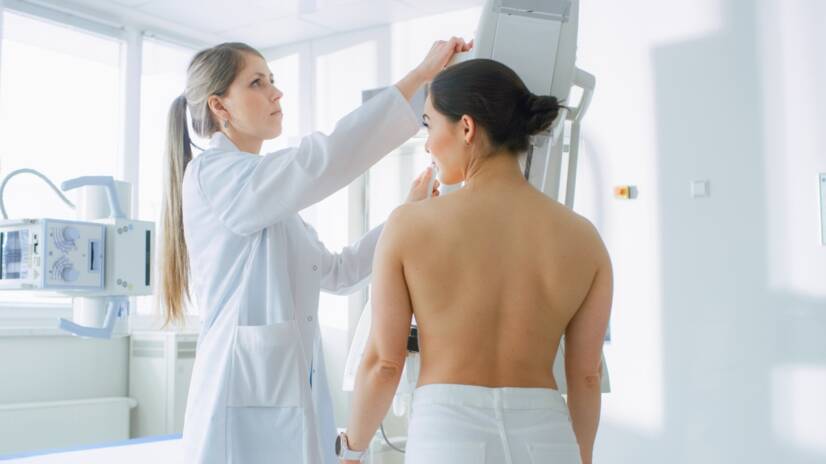
Breast cancer is the most common cancer in women. Its incidence in the population is increasing. Early diagnosis is important for the prognosis of treatment. What is breast cancer prevention and screening?
Article content
Breast cancer
Breast cancer arises from the breast tissue's own cells that have begun to grow abnormally and have formed a lump or tumour.
An earlier stage of the disease is the appearance of abnormal cells in the milk ducts or mammary glands without spreading to the breast tissue.
Conversely, the later stage results in the spread of the disease to the breast and surrounding lymph nodes.
The exact stages of the disease are divided according to the amount of spread (stage 0-4), invasiveness and the specific type of cancer according to hormone receptors (HR, HER2).
Breast cancer statistics
Breast cancer is the most common cause of cancer death in women. It is most common in women after the age of 50. Breast cancer can also be diagnosed in men on rare occasions.
Statistics show that approximately one in eight women will develop breast cancer in their lifetime. From 1976 to 2009, the number of women diagnosed almost doubled.
The global incidence of breast cancer in women is not uniform. The highest incidence is in Europe and North America, with lower rates in South America and Asia, where other types of cancer are found.
Cause and aetiology
The exact cause of breast cancer is currently unknown. However, a number of confirmed risk factors have been identified.
Family history plays a very important diagnostic role.
Having a close family member diagnosed with breast cancer, such as a parent or sibling, means that women have twice the risk of developing breast cancer compared to women without such a family history.
Older age and menopause are also risk factors. 6% of women will get the disease between the ages of 30 and 40. The highest incidence is around the age of 64.
Risk factors for breast cancer:
- Female gender
- Race
- Older age
- Genetic factor
- Family history
- Hormonal imbalance
- Non-malignant breast disease
- Mammary gland density
- Fewer children (births)
- Obesity
- Alcohol and smoking
- Excessive ionizing radiation
Symptoms of breast cancer
The main outwardly noticeable symptom is a change in the surface and appearance of the breast and breast area. It is therefore important to recognise and notice your breasts during everyday activities such as dressing, showering and bathing.
When the breasts change, an early visit to the gynaecologist is essential. There is no need to be alarmed. It may not be cancer, but the cause of the symptoms needs to be identified and appropriate treatment determined.
Prevention (perception of the symptoms and signals of the human body) serves to control the state of health, promote health and early diagnosis of unwanted diseases.
Diagnosis at an early stage significantly improves the prognosis for cancer treatment.
The most common symptoms of breast cancer:
- A palpable lump in the breast
- Pain in the breast and breast area
- Swelling and lump in the breast
- Change in breast size and shape
- Nipple discharge (bloody, white, lymphoid)
- Nipple pulled inwards
- Thickening of the skin and tissue of the breast
- Breast discoloration and redness
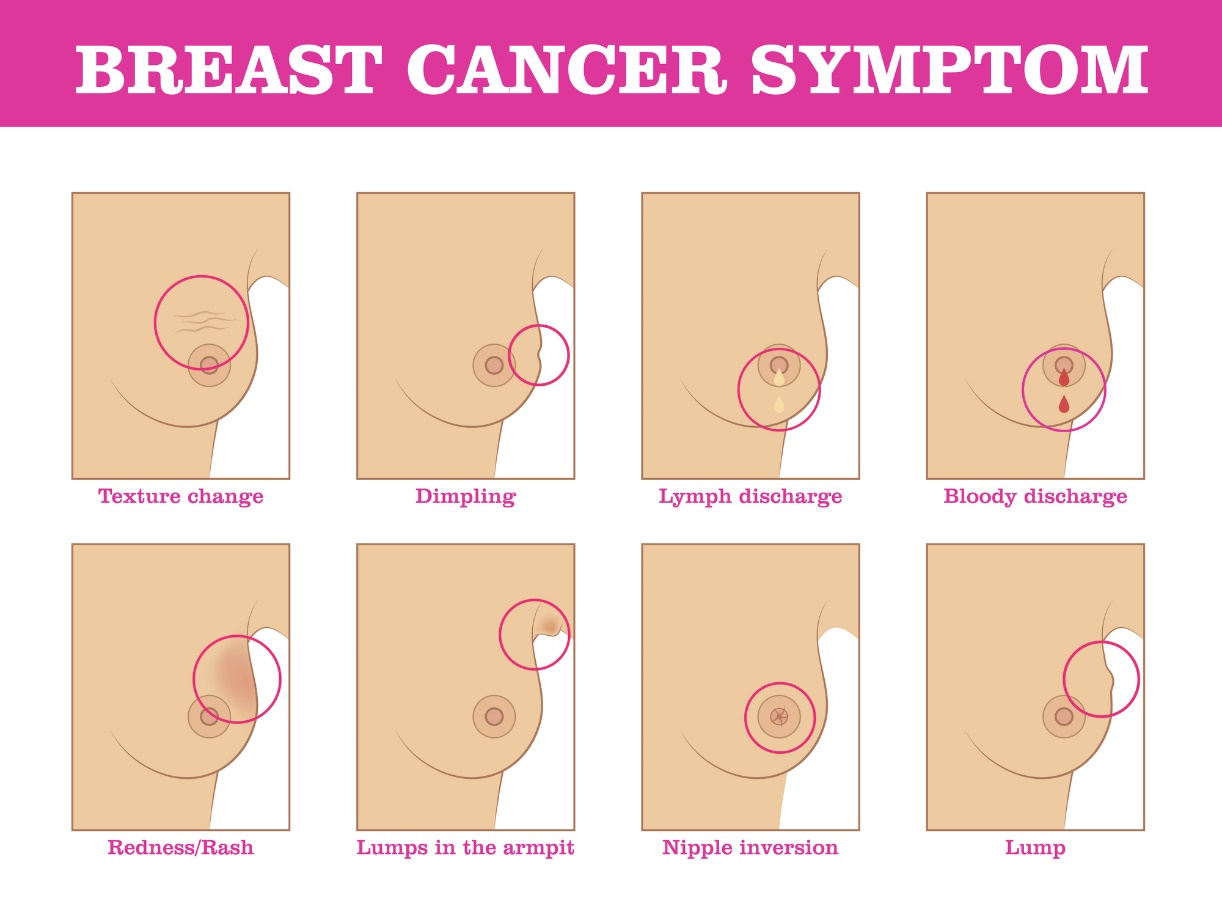
Prevention of breast cancer
Breast self-examination once a month is an essential point of prevention. Recent surveys show that 75% of respondents are aware of the possibility of breast self-examination and only 10% of women perform this examination.
The first signs are often noticed by the women themselves, as they can check themselves more often than a gynaecologist. At risk age, it is recommended to perform breast self-examination more regularly.
During the self-examination, it is essential to palpate the whole breast and the breast area with your fingertips. It is important to focus on the nipples, the lymph nodes in the armpit, the nipple area and the structure of the breast tissue itself.
It is ideal to perform the examination in front of a mirror where the colour and shape changes of both breasts can be better observed. It is recommended to raise the arm up on the side to be examined.
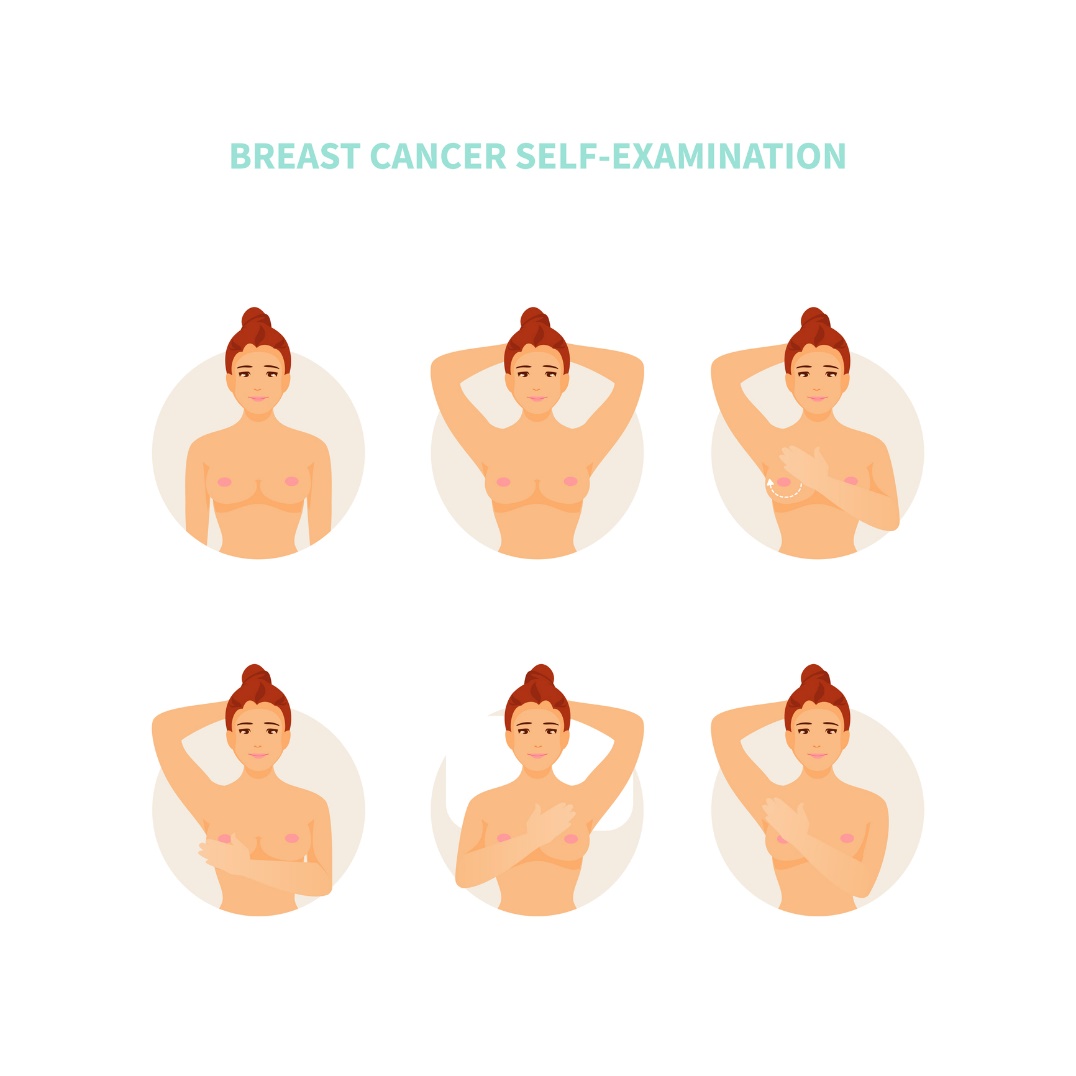
Professional prevention consists of regular check-ups with a gynaecologist in terms of preventive examinations, ultrasound and mammography and magnetic resonance imaging (MRI).
Ultrasound examination
Ultrasound (sound wave) sonography uses high-frequency sound to create an internal image of the breast tissue.
A handheld ultrasound head allows the doctor to examine the breast, breast area, and lymph nodes in the armpit. Ultrasound can determine if a lump is made up of solid tissue or if it is a cyst with fluid contents.
Mammography
Mammography is an essential diagnostic and preventive breast screening method for women over 40 years of age. Mammography is able to detect pathological changes in mammary gland tissue over time.
Mammography is capable of detecting non-palpable and ultrasound-visible changes over time. It is capable of detecting early abnormal manifestations of the mammary gland.
A mammograph is an X-ray machine that uses low-energy soft X-rays (25-30 keV). It works by densitometry - measuring the density of tissue through which the radiation penetrates.
The sensitivity and diagnostic ability of the device is approximately 86% for early stages of cancer.
Facts and myths about mammography
Facts...
Mammography screening has been performed in European Union countries for several decades. It has been found that women who get screened between the ages of 50 and 69 have a 35% reduction in breast cancer mortality.
Regular screening mammography is therefore very important.
There are rumours and myths circulating on the internet about the harms of mammography screening. However, this information is not supported by relevant scientific studies.
If a woman is unsure about the harms due to her medical condition, a consultation with her doctor is recommended.
We often hear...
1. It is a myth that the painfulness of the examination is harmful. The fact is that the mammography machine compresses the breast for a few seconds at most with pressure that does not cause subsequent health problems.
The female mammary gland is resistant and adapted to similar stresses (pregnancy, breastfeeding).
The second myth is the harmfulness of radiation. The truth is that the radiation load used in modern mammography is minimal and several times lower than that of conventional X-ray or CT diagnostic machines.
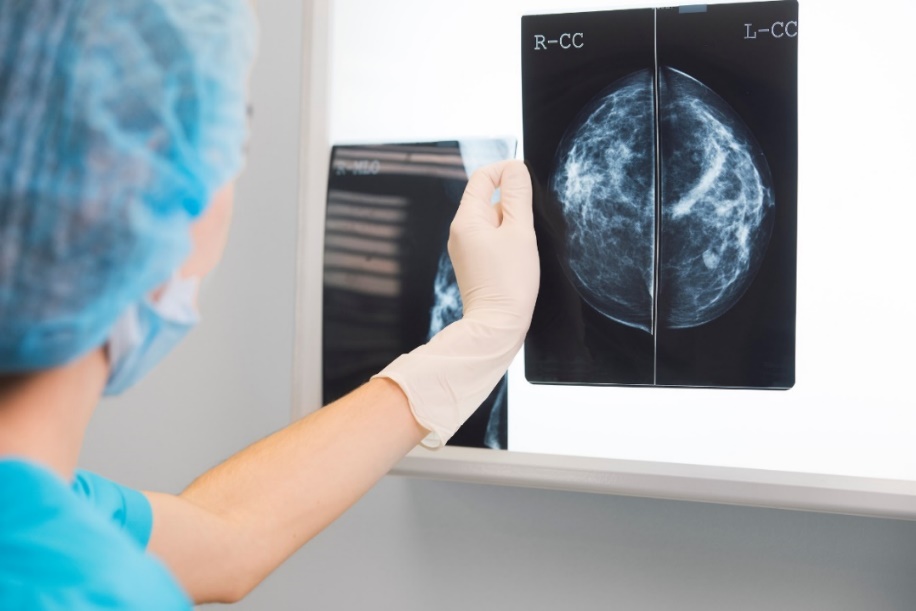
MRI (magnetic resonance imaging)
The MRI method uses magnetic and radio waves to create an internal image of the body's tissues. MRI is not part of routine preventive screening. It is used in patients with a family history of breast cancer or breast implants. It is also used as a screening method in breast cancer treatment.
Lifestyle prevention
The basic prevention against cancer and disease in general is lifestyle.
A regular nutritionally balanced diet is recommended, which includes increased intake of protein, vegetables and fruit, healthy fats (fish, Mediterranean diet, nuts, avocados), fibre, soya products and legumes. Vitamin D intake is also important.
It is important to avoid alcohol and smoking as a means of preventing the risk of cancer.
It is also recommended to engage in regular, adequate physical activity of a corrective and compensatory nature with regard to daily social and occupational activities.
Various natural dietary supplements are currently available to support breast health and overall women's health. However, it is necessary to carefully consider the composition with regard to possible risks and contraindications.
In case of doubt, it is advisable to contact a doctor.
Breast cancer treatment
The type of treatment always depends on a number of factors: the stage of the disease, symptoms, invasiveness, type of cancer, health risk assessment and the patient's medical history. Often it is a treatment that places an excessive burden on the human body.
Types of breast cancer treatment:
- Surgical treatment
- Radiotherapy
- Chemotherapy
- Hormonal treatment
- Immune therapy
- Targeted treatment
Surgical treatment may be "breast-conserving surgery" in which the tumor is removed but healthy breast tissue is preserved. The other option is mastectomy, in which the entire breast is surgically removed.
Radiotherapy is a type of treatment that uses ionizing radiation to damage abnormal breast cells and cause them to die. Radiotherapy is usually indicated after surgery.
Chemotherapy, in which special substances are injected into the body, gradually destroys developing breast cancer cells.
Chemotherapy is usually given cyclically every 1-3 weeks by intravenous infusion. After the standard intravenous chemotherapy is finished, additional oral chemotherapy may then be given.
Hormonal therapy, pharmacotherapy administered orally and intravenously, has the primary goal of reducing the effects of estrogen in special ER-positive breast cancers.
Immunotherapy (immune therapy) in the fight against cancer uses pharmacotherapy to stimulate the patient's own immune system to more effectively recognize and then destroy breast cancer cells.
Targeted therapy involves the use of drugs and medications that block specific signals in the tumor cells to promote the growth and proliferation of abnormal breast cancer cells.
The type of therapy chosen is individual and depends primarily on the specific type and type of breast cancer.
Pink October (Breast Cancer Awareness Month)
Pink October is Breast Cancer Awareness and Prevention Month. Many walks, lectures, collections and campaigns are held around the world.
Most often, these events are organised by alliances and support groups for women battling breast cancer. They also present stories of women who have overcome the disease.
The symbol of awareness and prevention of this disease is the colour pink and the pink minimalist ribbon.
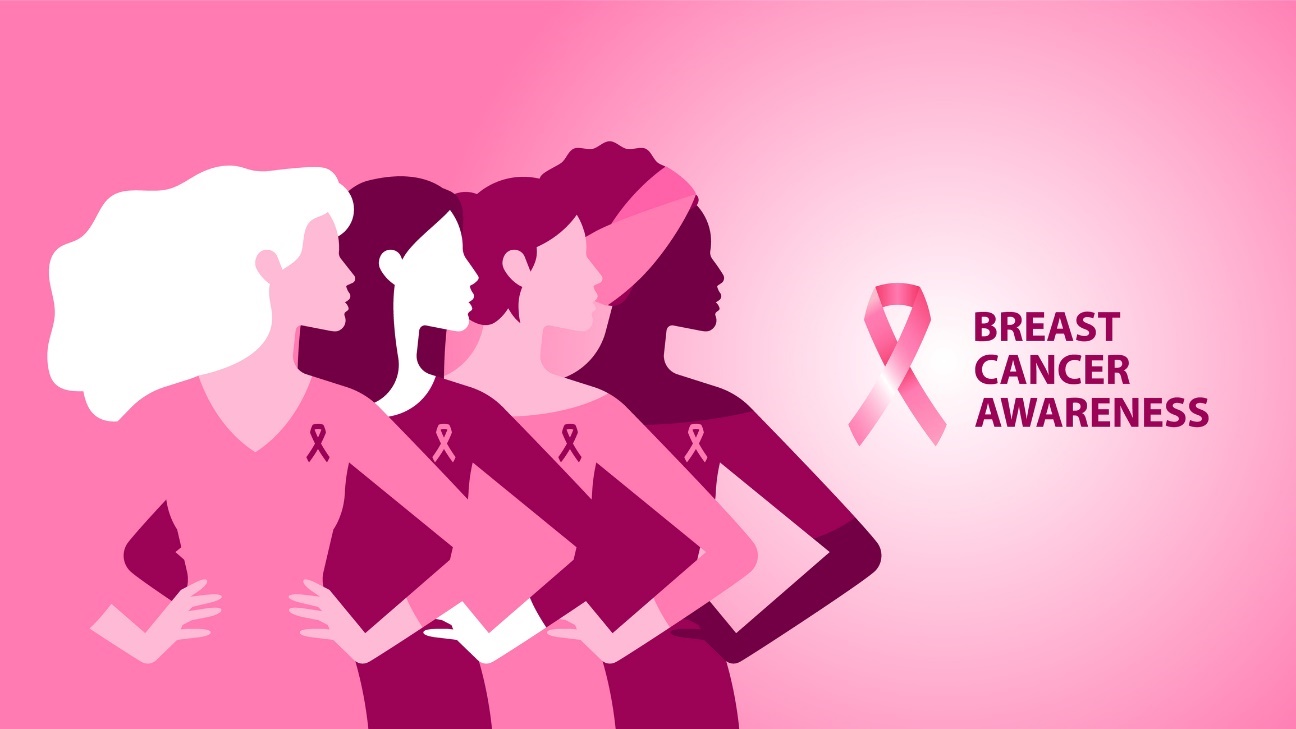
Interesting resources










